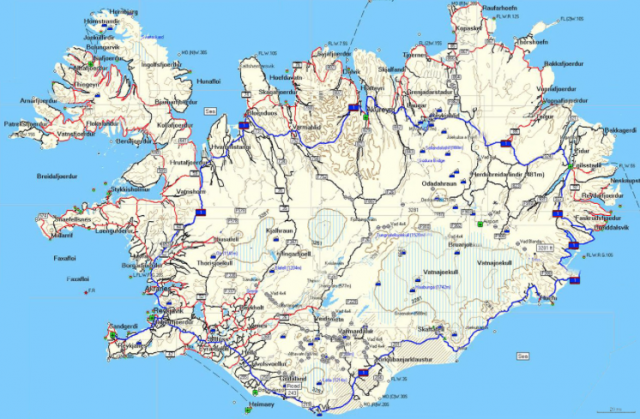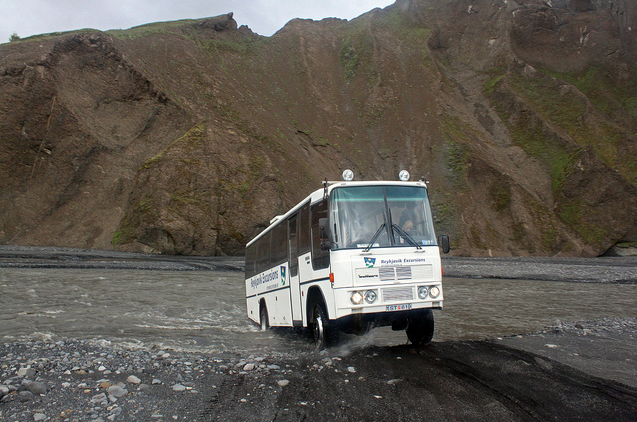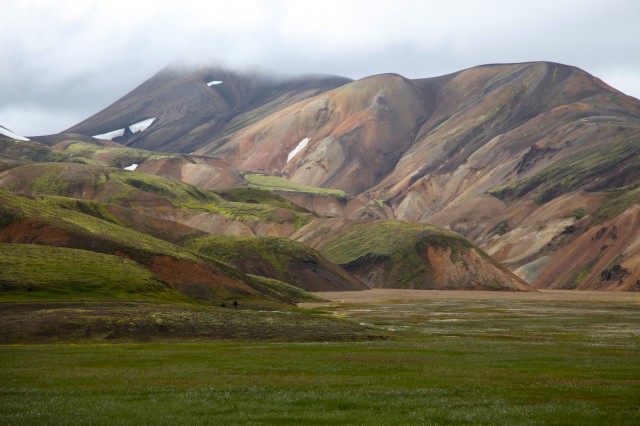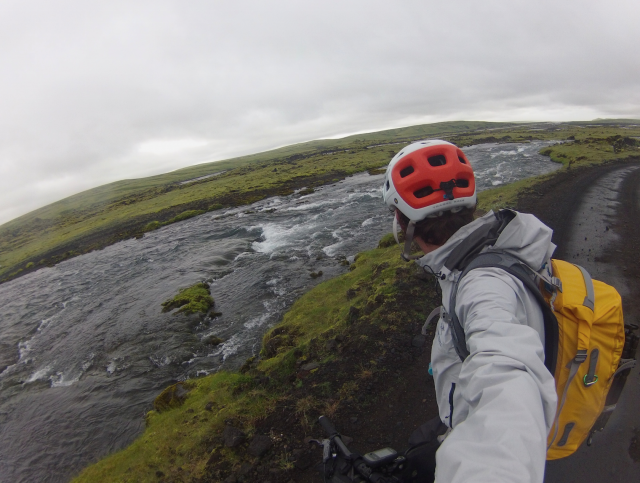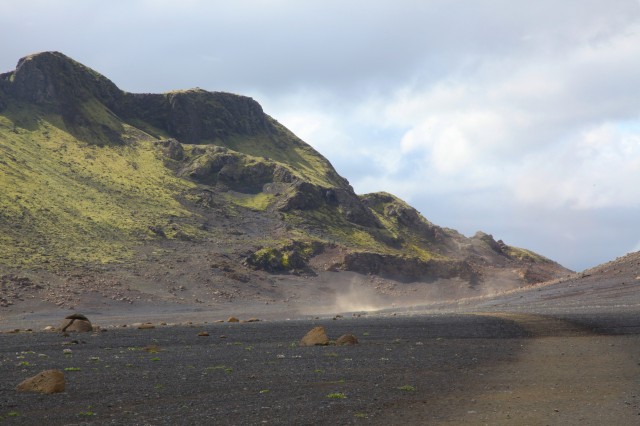When I stepped off the plane in Keflavik, Iceland with my bike box in tow, I was well aware I was not the first cyclist to visit the country. That honor falls to Horace Dall and his 1933 crossing of the island. What I didn’t expect was seeing a Facebook post from my near-neighbor Kurt Refsnider that he too was in Reykjavik. Then there was my friend Chris Reichel who was inbound a couple weeks later, and Brett Davis and crew who had left just a couple weeks prior. It would seem Iceland––is the place to ride.
Having spent all of July in Iceland, the bulk of that in the rugged interior atop my Salsa Bucksaw, I can understand the allure it holds for adventure cyclists. It is a magical landscape seemingly ripped from the pages of a fantasy novel. At nearly every turn I half expected Bilbo Baggins to grab me by the arm and shuttle me off to Middle Earth. There were scads of things that I had prepared myself for, but a ton more elements of bike travel in Iceland that truly caught me off guard. Below is my overview of how to plan for your own Icelandic bikepacking odyssey.
The complete story from my journey will be available in print in the 2015 Gear Guide issue of Overland Journal.
Where the hell is Iceland, anyway?
Shocking as it sounds, many people haven’t a clue where this tiny island is, or what treasures it holds. At roughly the size of Kentucky, it is a remote island positioned just a few miles below the Arctic Circle somewhat equal distance between Greenland and Norway. It is a relatively new island formed by a volcanic hotspot. The human history is equally young with the land first settled only about 1,000 years ago. That history is filled with stories of vikings and settlers, fisherman and farmers. It makes for a fun backdrop to adventures in Iceland.
Getting There.
Because Iceland is enjoying an accelerated boom in tourism, there are a number of flights arriving at the main airport in Keflavik, 45 minutes south of the capital city of Reykjavik, with increasing regularity. Some airlines are running multiple flights daily from major airports departing the U.S. and Europe. As such, fares are becoming more than reasonable. Even for me in Arizona, a round trip ticket to Keflavik in the high season was only $985.
Weather, daylight, and when to go.
Although the tourism season has pushed well beyond the summer months, bikepacking season generally runs from late June to mid September. Given its location in the North Atlantic, it has a cool but temperate climate for most of the year. Summer temperatures from June through August tend to hover around 55ºF give or take 10ºF. Because of its northern location, summer daylight hours can often provide ample riding light for 20 hours of each day. In July, there’s really no need for lights of any kind. That limited amount of darkness is also what keeps day and nighttime temperatures so consistent with minimal temperature swings.
The two most daunting weather challenges in Iceland are relative to rain and wind. Wind can often present the most brutal conditions with sustained blows often exceeding 50 mph. Many riders have lost entire days of progress as winds kept them pinned down. Rain is another near constant and can range from a drizzle to intense downpours. All in all, it’s best to just expect a little of everything in any given week from sunshine to Biblical weather epics. It is necessary to pad your schedule with weather days as they will likely happen.
The shoulder seasons can present significant challenges with either residual spring snow, or late season snow. There’s also the potential for high river levels during the early season as snow melt increases with summer temps. It’s important to note that almost all of the interior roads are closed with the first snow.
Gear for Extremes
Given the wet and severe weather of the North Atlantic, it is of critical importance you pack the best weatherproof gear possible. Temperatures are seldom the issue, although higher elevations (only 3,000 feet) can be quite cold when combined with wind and rain. It wasn’t uncommon for a higher elevation to drop into the mid 40s. It is extremely important to wear the very best waterproof jacket and pants you can afford. I spent several days in my GoreTex suit, hood pulled tight, and still got somewhat wet. And that tent you think is so awesome…it probably won’t hold up to the high winds. It is advisable to pack a hoop tent, one designed specifically for high winds.
Since I was toting a bunch of professional camera gear, I went with a waterproof backpack, something I would fully recommend even if just used to protect your critical gear. I highly recommend the Sea to Summit Carve 24 Liter backpack and the Terra Nova Laser Comp 1 tent.
Grumpy geothermal activity.
Iceland is rife with geothermal activity, which is why it’s so awesome. The island’s many volcanoes erupt with regularity and this past season was no different. Prior to my trip in July 2014, warnings were issued stating that geothermal activity had threatened severe glacial melting resulting in the portent of serious floods. There was also mention of harmful gasses near some glacial lakes and rivers. As luck would have it, all was fine for my trip, but just two weeks later a different volcano erupted in full. It caused road closures which stymied some bikepacker’s plans. Plan on the unplanned, even with regard to volcanic eruptions.
Huge piles, and indeed entire mountains, of black volcanic ash are everywhere in the interior.
Getting around.
There are many options available for ground transportation. Aside from dozens of rental car options, there are buses and domestic flights to nearly every corner of the island. Reykjavik Excursions [https://www.re.is] is the major bus line providing service to the most remote destinations via their impressive off-road buses. Prices are reasonable with a fare across the entire island likely not to exceed $120. It can be tricky getting your bike on some buses as they will only accept a bike if there is space for it, and there will be an additional fee.
Hitch hiking is a popular mode of travel, but not an ideal solution for the bikepacker. Hordes of trekkers can be seen lined up at the edge of every small village as they work their way into the interior. If nothing else, there’s a lot of competition for open seats.
The main bus station is in Reykjavik near the domestic airport close to the center of the city. Most trips to the other parts of the island depart from this, the BSI, bus station.
There is a public city bus you can use to get around the greater Reykjavik area at a minimal cost. I used it to get from my hotel in Hapnarfjordur to the BSI station at a cost of just a few dollars. Although it is possible to ride around Reykjavik by bike, it can be a navigational challenge. There are loads of bike paths if you can figure out how to best use them to get where you want to go.
Don’t plan on taking a taxi unless you want to blow all of your beer money goodbye. A taxi from the airport to Reykjavik is easily $120. Even a taxi from Harfnarfjordur to the BSI station set me back $50 for the 15 minute ride, but I was in a time crunch to get there for my 6am bus.
From the airport to Reykjavik.
The main international airport at Keflavik, just 45 minutes south of Reykjavik, is tiny and as such makes for a great entry point. Once you pass through customs, you enter into a small receiving area with the usual ticket counters for buses and rental cars. Look for the Fly Bus as offered through Reykjavik Excursions. You’ll need to buy a ticket to Reykjavik for you and your bike, a total cost of roughly $45. The buses are parked just one hundred feet outside the main doors and hard to miss. These buses can also transport you directly to some hotels.
Resources and supplies.
There are camping stores in Reykjavik, Hafnarfjordur (20 minutes south) and in Akureyri, the largest city in the north. There are a few bike shops in the capital city, and one in the southern town of Selfoss.
It’s important to be aware of how few towns and villages there are in Iceland. The vast majority of the Icelandic populous lives in the capital city and surrounding areas. Akureyri is the largest city outside of the western aspect of the country and most villages in the rest of the island have fewer than 500, if not 100 residents. Looking at a map of the island is deceptive as many place names indicate individual farms rather than townships. Regarding the interior of the island, there is effectively nothing with regard to resupply points. Once inside the paved Ring Road that incircles the island, you can expect no options for resupply. I will say that again––there are no resupply options in the interior of the island…at all.
I think I drank my weight in Gull beers when the opportunity presented itself. These beers were given to me by three Swedes I met in a campground. No, they didn’t last long.
F roads and other tracks.
Iceland is literally webbed with tiny backroads prime for bicycles. Many people underestimate the challenge these roads provide the bikepacker and don’t fully appreciate how fun they are to ride. Many are steep enough to make a billy goat cry. They can also be sandy, potholed, and many intersect with dozens of rivers, most without bridges. It is possible to string together several days worth of F roads creating a challenging and fun experience. I traversed a couple hundred miles of F roads on my trip and was nackered. Some of them are quite hard, steep enough to even require a little hike-a-bike.
In many places the F Roads were little more than rough paths just ten feet wide. I didn’t see another human on this road for 36 hours. Solitude can be found, even on well developed roads.
To Fatbike or Not to Fatbike
Part of the reason so many riders are heading to Iceland can be attributed to the advent of the fatbike. These bikes love varied terrain, and Iceland certainly has that. Because I was on a fatbike, and most importantly, a pre-production full suspension Salsa Bucksaw, I was able to tackle sandy roads, black sand beach, volcanic deserts and anything else in my path. It proved a perfect platform.
Many riders still opt to travel the island by traditional bikes, either on mountain or road wheels, but even a standard mountain bike wheel will struggle on some developed and maintained F roads due to the sandy conditions. For that reason, I strongly agree with many that the fatbike is the ideal option for this tough terrain. I can’t imagine not having my Bucksaw for this ride. It was perfect, even when riding 20-30 mile stretches of pavement to access the interior roads.
And, as of this month, Bucksaw bikes should be hitting your local Salsa Dealer. I owe Salsa Cycles a heartfelt thank you for letting me test their latest fatbike in such an extreme setting.
Singletrack and trail systems.
This is where I struggle to not fold in a subjective bit of personal opinion. Icelandic mountain bikers are quick to laud their network of trails, and will quickly tell you how great they are. Maybe I’m spoiled, but much of the singletrack in Iceland as adopted by mountain bikers, was originally designed for trekkers. As such, it can often be very steep, very loose, and involve hours of hike-a-bike. The famed trekking route of the Laugavegur is a prime example. Having ridden it, I admit I really hiked it, all 50+ miles of it when connected from Landmannalauger to Skogar.
The other less than ideal element to Icelandic singletrack is how disconnected and short much of it is. Good trail can be found, but many segments are short, don’t link well to other trails, or start and end in strange areas. Akureyri has a nice network of trails, as does Reykjavik, but for the bikepacker, not many trail systems further inland link together for a continuous multi-day singletrack ride. However, fold in some F roads with some of the interior’s more austere “tracks” and you have one heck of an adventure.
One word of route warning: Venture off designated trails and roads and you could find yourself facing very stiff fines if not criminal charges. Stay the trail, road, or other designated route. Icelanders are feeling the effects of unauthorized off-road travel and it’s a raw nerve. Don’t get off proper routes.
Where to, and not to camp.
Because of the influx of tourists as of late, Icelandic authorities are beginning to crack down on at-large campers. Iceland’s environment is delicate and also more developed than many bikepacker’s realize. The entire island is ringed with farmland, so just plopping down a tent in the nearest patch of grass is likely to put you on someone’s private land. Stories abound of this not being an issue, but I think those days are over. I did see one bicycle tourist being issued a fine and invitation to come back to appear in court. He also said the land owner chewed his ear off for a good half hour while he packed his things.
In the interior of the island where private land is less prevalent, wild camping is the norm, but realize how rugged the landscape is. Jagged rocks and low bushes can dominate the ground for dozens of square miles. Wild camping is also prohibited in some nature preserves and parks. Just don’t assume you can camp anywhere you please.
It would be safe to say that Icelanders are an outdoorsy bunch and as such have a good network of designated campgrounds that are typically extremely clean, have nice amenities, and don’t cost much more than $10 per person. Most designated camping areas are located along the paved Ring Road, usually near or in small villages.
Budgeting for expenses.
The only thing to say here is, bring lots of funds. As of this year, gas is around $8/gal, beers in most restaurants cost $9, and hotels easily reach into the $200 range. Food is very expensive, car rentals are extremely high, and in general it is an expensive place to travel. You can trim these expenses if you’re careful and forego the island’s travel luxuries.
Route planning.
Bikepackers, like many travelers, often sucker themselves into the pitfall of planning routes just because they either cross or circumnavigate a given plot of earth. Riders hell bent on crossing the island as their main objective often fail to experience the many varied and beautiful places of Iceland. Same for those hell bent on just riding around the island. It’s not a big place and there are ways to design routes to get maximum experience, but you may have to couch your ambitions to say to friends at cocktail parties, “I rode all the way around Iceland…” The best routes often hone in on a small and diverse region and employ a host of paved roads, F roads, trails, and tracks. If you aspire to design a route with all singletrack, you’ll likely not find such a route, and if you do, will likely miss places like this one pictured below.
Many Rivers to Cross.
It might be the most underestimated component to Icelandic bikepacking logistics. Iceland is home to thousands of rivers and streams, some small enough you can step over them, many too large to even brave with a pack raft. If there is anything that is most likely to thwart a given route, it will be a river. On my recent trip to Iceland, I crossed 54 rivers, counting every crossing that wetted my feet during a 12 day trip. Every year people die, or nearly die, crossing the country’s wild waters. There are rare opportunities to hitch rides across some rivers by passers-by in big trucks, but don’t count on it. For one section of my trip, I had to book a ticket on a Reykjavik Excursions off-road bus to get me beyond one whopper of a river. I did have one 35 mile detour around a big river and after a five day period of rain, even one footbridge failed to span the full width of another river. I also had one crossing that scared the hell out of me with water up to my chamois. Rivers are a serious element to bikepacking Iceland.
The river on the left was not a problem at only thigh-deep, although I was well practiced with my fording skills by day five. The river on the right did thwart my progress resulting in a five hour detour, but only after I spent 30 minutes trying to cross it. I fell in that river, nearly lost my bike, and felt like a proper idiot for the attempt. It could have been ugly.
Drinking Water.
One of the best aspects of travel in Iceland is the water quality. Known for the cleanest water in the world, I just drank right out of the wild streams almost never carrying more than a single liter of water. You will have to quickly develop your water-scouting skills as any river originating from a glacier will be heavily silted with sediment. All other rivers will be crystal clear.
Language and Locals.
Although Icelanders primarily speak their native language, nearly everyone in the service sector, and almost anyone under the age of 30, speaks English. They’re also a friendly lot, eager to help and generally very welcoming to tourists.
It’s a beautiful country, full of breathtaking views. It’s not an easy country to travel by bicycle as the elements and scale of the landscape can take a toll. Like all wilderness destinations, expect to have your best laid plans challenged if not thrown out the window outright. Be prepared for setbacks and they will eventually become highlights of an adventure of your lifetime.
My Favorite Icelandic Resources
The Hotel Hafnarfjordur: This simple hotel is located in the harbor town of Hafnarfjordur, one of the old viking villages of antiquity. It’s a clean hotel with storage for bike boxes and a very friendly staff, which as of this summer, is well acquainted with stinky bikepackers. The Fly Bus stops right at their front doors for easy to/from airport transport. It’s only 20 minutes into the center of Reykjavik from here. There is also a camping store on the same block as the hotel. Hotel Hafnarfjordur
The Blue Lagoon: Ya, it’s touristy. You’ll be processed like cattle, but after the first beer and ten minutes in the hot water, you won’t care. It’s one of those must-do experiences that probably is worthy of that status. It makes for a nice end to a backcountry trip.
Blue Car Rental: If you need a rental car, look no further. These guys are the best in the business. Blue Car Rental
The Lebowski Bar: Downtown Reykjavik is well known for letting the booze flow freely, and there’s no better place to start your celebratory night out after a big bike trip than at the Lebowski Bar. Why? I don’t know man, but the rug really ties the room together.



